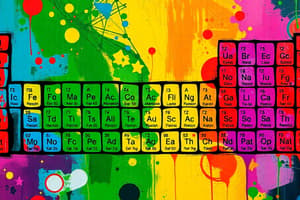Podcast
Questions and Answers
What is the main difference between inorganic chemistry and organic chemistry?
What is the main difference between inorganic chemistry and organic chemistry?
- Inorganic chemistry studies living organisms made mostly of carbon, while organic chemistry focuses on nonliving materials without carbon chains.
- Inorganic chemistry focuses on living organisms made mostly of carbon, while organic chemistry studies nonliving materials without carbon chains.
- Inorganic chemistry involves the study of carbon-based compounds, while organic chemistry focuses on materials without carbon chains.
- Inorganic chemistry studies nonliving materials without carbon chains, while organic chemistry focuses on living organisms made mostly of carbon. (correct)
What are the five main types of chemical reactions?
What are the five main types of chemical reactions?
- Combination, decomposition, single displacement, double displacement, combustion (correct)
- Reduction, oxidation, hydrolysis, neutralization, synthesis
- Evaporation, melting, freezing, boiling, crystallization
- Ionization, vaporization, condensation, sublimation, fusion
Which element occupies a column to itself in the periodic table?
Which element occupies a column to itself in the periodic table?
- Beryllium
- Helium
- Hydrogen (correct)
- Lithium
What type of reactions involve replacing one substance with another?
What type of reactions involve replacing one substance with another?
What do solutions containing solutes dissolved in solvents have the ability to conduct?
What do solutions containing solutes dissolved in solvents have the ability to conduct?
Which type of chemical reaction involves combining simple substances to make new complex ones?
Which type of chemical reaction involves combining simple substances to make new complex ones?
What is the main focus of chemistry as described in the text?
What is the main focus of chemistry as described in the text?
What is the significance of the atomic number in an atom?
What is the significance of the atomic number in an atom?
How do electron shells behave when they gain energy from external sources?
How do electron shells behave when they gain energy from external sources?
What does the Periodic Table organize in increasing atomic weight?
What does the Periodic Table organize in increasing atomic weight?
In atomic structure, what role do neutrons play?
In atomic structure, what role do neutrons play?
What happens when electrons move back to lower energy levels after being excited?
What happens when electrons move back to lower energy levels after being excited?
Flashcards are hidden until you start studying
Study Notes
Chemistry is the study of matter and its interactions with energy. It encompasses fields such as biochemistry, physical chemistry, organic chemistry, analytical chemistry, polymer chemistry, materials science, forensic chemistry, nuclear chemistry, astrochemistry, geochemistry, and environmental chemistry. Atoms make up elements, which combine through chemical bonds to form compounds like molecules—the building blocks of everything around us.
Atomic structure refers to how atoms are built within their nucleus and electron shells. The atomic number describes the number of protons in an atom's nucleus, while the mass number includes both protons and neutrons. Hydrogen has one proton, and all other atoms have at least two electrons. Electron shells have different energies; when they gain energy from outside sources like light, food, or electricity, electrons move into higher levels and release energy. This movement releases heat and light, making things hotter or brighter.
The Periodic Table contains every element discovered so far, organized by increasing atomic weight. Each row represents a period, showing patterns between neighboring elements. For example, hydrogen occupies a column to itself, lithium is next on the left side of the table, then beryllium, boron, carbon, nitrogen, oxygen, fluorine, sodium, magnesium, aluminum, silicon, phosphorus, sulfur, chlorine, potassium, calcium, scandium, titanium, vanadium, chromium, manganese, iron, cobalt, nickel, copper, zinc, gallium, germanium, tin, lead, radon, polonium, astatine, radium, actinium, thorium, protactinium, uranium, neptunium, plutonium, americium, curium, berkelium, californium, einsteinium, fermium, mendelevium, nobelium, radon, radium, actinium, thorium, protactinium, uranium, neptunium, plutonium, americium, curium, berkelium, californium, einsteinium, fermium, mendelevium, nobelium, and lawrencium.
Chemists often work with solutions containing solutes dissolved in solvents. Solutions can conduct heat or charge, affecting the phase changes of substances near them, causing reactions called precipitations. Inorganic chemistry studies nonliving materials without carbon chains and organic chemistry focuses on living organisms made mostly of carbon.
Reactions occur whenever chemicals mix and interact with each other because the reactants want to reach a more stable state—a lower energy level where there aren't any missing or extra pieces. Reactions fall into five main types: combination, decomposition, single displacement, double displacement, and combustion. Combination involves combining simple substances to make new complex ones, decomposing splits apart big complicated substances back into simpler ones, single displacement replaces one substance with another, and double displacement exchanges substances. Double displacement also makes salts, which are ionic compounds that dissolve easily in water.
Studying That Suits You
Use AI to generate personalized quizzes and flashcards to suit your learning preferences.




